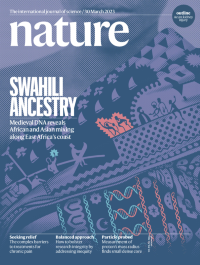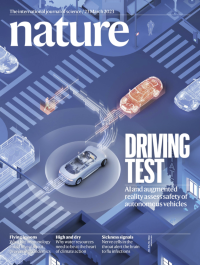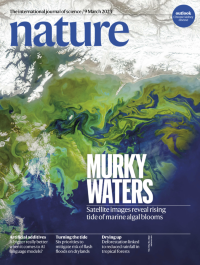Volume 615
-
No. 7954 30 March 2023
Swahili ancestryMedieval people on the Swahili coast of East Africa were among the first sub-Saharan people to practise Islam. David Reich, Chapurukha Kusimba and colleagues sequenced DNA from 80 individuals buried in six medieval and early modern coastal Swahili stone towns, dating between 1250 and 1800. Their analysis shows that African women and Asian men began mixing along the East African coast before the year 1000, and that the earliest Asian migrants were of largely Persian origin. These findings match the Kilwa Chronicle, the oldest story told by the people of the Swahili coast. About one-tenth of the ancestry of the earliest Asian migrants came from India. The cover image is adapted from a photograph of a Swahili woman in Zanzibar taken in 1896. The textile patterns of the garment have been redrawn to reflect themes in the paper, including DNA, medieval dhows to signify trade, and symbols from Islam to represent cultural influence.
Nature Outline
-
No. 7953 23 March 2023
Driving testOne of the main hurdles to putting autonomous cars on the road is how to ensure the reliability of the artificial intelligence that replaces the human driver. Evaluating the safety of an AI driver to the level of a human in a naturalistic environment would require testing across hundreds of millions of miles — something that is clearly impractical. In this week’s issue, Henry Liu and his colleagues tackle this problem by training an AI to help test the AI in the driving seat. The researchers used dense deep reinforcement learning to train the AI tester, which allowed the tester to ignore safe scenarios and instead build a testing environment that focused on potentially dangerous situations. The team then successfully tested a real car using augmented reality — while the autonomous vehicle drove round a track it had to cope with virtual dangers set by the tester. The researchers say the system can speed up safety evaluations by several orders of magnitude.
-
No. 7952 16 March 2023
Twist factorChiral molecules are structures that have the same composition but are mirror images of each other. In this week’s issue, Nicholas Kotov and his colleagues use self-assembling nanosheets that form bow-tie-like microparticles to examine whether it is practical to use geometrical measures of chirality for chemical structures. The nanosheets hierarchically assemble into nanoribbons that stack together and twist to look like bow ties (as pictured on the cover), with the direction of twist depending on the chirality of the molecules used to form the nanosheets. Crucially, the twist angle of the bow ties is highly controllable. The team found that the various bow-tie particles interacted differently with circularly polarized light depending on their chirality measure. The researchers also printed their bow-tie particles onto fabric, creating photonically active metasurfaces that they suggest could form the basis for fiducial markers for lidars.
-
No. 7951 9 March 2023
Murky watersThe cover image shows an algal bloom off the coast of Alaska in 2017. Phytoplankton blooms are accumulations of microscopic algae in the surface layer of water systems. Although they can provide food and nutrients for other organisms, they can also cause serious environmental problems. In this week’s issue, Lian Feng and colleagues present a comprehensive map of bloom distribution and trends in coastal waters. The researchers assessed 760,000 images captured by NASA’s Aqua satellite between 2003 and 2020, and identified blooms on the coast of 126 of the 153 ocean-bordering countries they examined. They found that the area of water affected by blooms expanded by 13.6% between 2003 and 2020, and that this increased bloom frequency correlated with changing ocean circulations and rising sea-surface temperatures.
Nature Outlook
-
No. 7950 2 March 2023
Root and branchTrees in dryland ecosystems play an important part in carbon cycling, but extensive data on their number and distribution have been lacking. In this week’s issue, Compton Tucker and his colleagues present an inventory of nearly 10 billion trees in sub-Saharan Africa. The researchers used machine learning to scan high-resolution satellite images to cover an area of nearly 10 million square kilometres. This allowed them to map individual trees and estimate the amount of carbon stored in the foliage, wood and roots of each tree. They divided the drylands into four zones, depending on the annual rainfall, and found that individual trees stored 51 kilograms of carbon in the driest regions, rising to 98 kilograms where the rainfall was greatest. The team has made a database of wood mass, foliage mass, root mass and carbon stock for each tree freely available (see go.nature.com/3ys6nhu).





